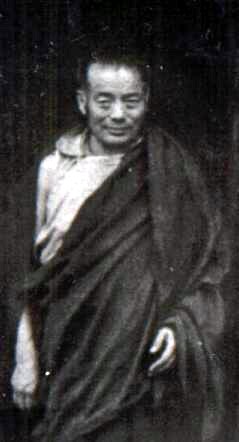Gyaltön Rinpoche: Difference between revisions
No edit summary |
No edit summary |
||
| Line 4: | Line 4: | ||
He was born c.1907 in Khyungpo in Kham, East Tibet and was recognized as the [[tulku]] of Saltong Shagom, an incarnation of one of [[Gampopa]]'s three main disciples known as 'the three men of Kham'. He was also known as an emanation of [[Manjushrimitra]], [[Nub Sangye Yeshe]] and Tsöndrü Senge. He studied with Situ Rinpoche at [[Palpung Monastery]] in Tibet, and then with Jamyang Khyentse Chökyi Lodrö, becoming one of his foremost disciples. He completed more than 100 million mantras of [[Amitabha]] and accomplished the practice of many other deities in retreat. | He was born c.1907 in Khyungpo in Kham, East Tibet and was recognized as the [[tulku]] of Saltong Shagom, an incarnation of one of [[Gampopa]]'s three main disciples known as 'the three men of Kham'. He was also known as an emanation of [[Manjushrimitra]], [[Nub Sangye Yeshe]] and Tsöndrü Senge. He studied with Situ Rinpoche at [[Palpung Monastery]] in Tibet, and then with Jamyang Khyentse Chökyi Lodrö, becoming one of his foremost disciples. He completed more than 100 million mantras of [[Amitabha]] and accomplished the practice of many other deities in retreat. | ||
He lived upstairs in the [[Palace Monastery]] in Sikkim, and was a teacher of [[Sogyal Rinpoche]], [[Dzongsar Khyentse Rinpoche]], [[Ringu Tulku]] and others. Towards the end of his life, following illness brought on by the hardships of a life spent in almost continuous retreat, often with very little food, he went on a pilgrimage to the sacred sites Nepal (December 1969 - Februrary 1970), giving away what little he owned as offerings before the ancient shrines he visited. He passed away on March 22nd 1970, remaining in the posture of [[Vajradhara]] for more than 48 hours, before his body was embalmed. In accordance with his wishes, expressed to the King of Sikkim, his body was cremated in the sacred site of [[Tashiding]] and his relics entombed in a [[stupa]] | He lived upstairs in the [[Palace Monastery]] in Sikkim, and was a teacher of [[Sogyal Rinpoche]], [[Dzongsar Khyentse Rinpoche]], [[Ringu Tulku]] and others. Towards the end of his life, following illness brought on by the hardships of a life spent in almost continuous retreat, often with very little food, he went on a pilgrimage to the sacred sites Nepal (December 1969 - Februrary 1970), giving away what little he owned as offerings before the ancient shrines he visited. He passed away on March 22nd 1970, remaining in the posture of [[Vajradhara]] for more than 48 hours, before his body was embalmed. In accordance with his wishes, expressed to the King of Sikkim, his body was cremated in the sacred site of [[Tashiding]] and his relics entombed in a [[stupa]] near that of his master, Jamyang Khyentse Chökyi Lodrö. | ||
Revision as of 15:46, 28 February 2007

Gyaltön Rinpoche (rgyal ston rin po che) aka Lama Saltong Shagom (bla ma gsal stong shva sgom) - an accomplished Kagyü master who was sent to the Palace Monastery in Sikkim by the Karmapa and performed many of the practices for Jamyang Khyentse Chökyi Lodrö when he was in ill and after he passed away in 1959 in Gangtok.
He was born c.1907 in Khyungpo in Kham, East Tibet and was recognized as the tulku of Saltong Shagom, an incarnation of one of Gampopa's three main disciples known as 'the three men of Kham'. He was also known as an emanation of Manjushrimitra, Nub Sangye Yeshe and Tsöndrü Senge. He studied with Situ Rinpoche at Palpung Monastery in Tibet, and then with Jamyang Khyentse Chökyi Lodrö, becoming one of his foremost disciples. He completed more than 100 million mantras of Amitabha and accomplished the practice of many other deities in retreat.
He lived upstairs in the Palace Monastery in Sikkim, and was a teacher of Sogyal Rinpoche, Dzongsar Khyentse Rinpoche, Ringu Tulku and others. Towards the end of his life, following illness brought on by the hardships of a life spent in almost continuous retreat, often with very little food, he went on a pilgrimage to the sacred sites Nepal (December 1969 - Februrary 1970), giving away what little he owned as offerings before the ancient shrines he visited. He passed away on March 22nd 1970, remaining in the posture of Vajradhara for more than 48 hours, before his body was embalmed. In accordance with his wishes, expressed to the King of Sikkim, his body was cremated in the sacred site of Tashiding and his relics entombed in a stupa near that of his master, Jamyang Khyentse Chökyi Lodrö.